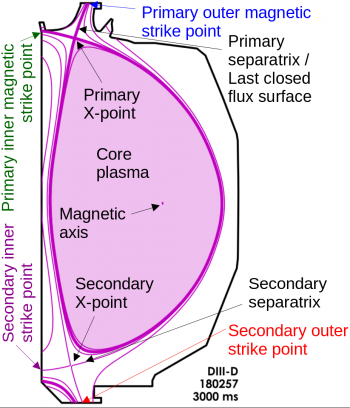Magnetic strike point: Difference between revisions
Created page with "350px|right|thumb|Cross section of a tokamak plasma (<math>R</math> increases to the right) with strike points and related features labeled. Magnet..." |
Add links |
||
| Line 1: | Line 1: | ||
[[File:Strike_points.png|350px|right|thumb|Cross section of a tokamak plasma (<math>R</math> increases to the right) with strike points and related features labeled.]] | [[File:Strike_points.png|350px|right|thumb|Cross section of a tokamak plasma (<math>R</math> increases to the right) with strike points and related features labeled.]] | ||
Magnetic strike points are where the separatrix of a diverted tokamak plasma intersects the wall. | Magnetic strike points are where the [[separatrix]] of a [[divertor|diverted]] [[tokamak]] plasma intersects the wall. | ||
Typically, the highest heat loads are deposited at the outer (large <math>R</math>) strike point of the primary separatrix. | Typically, the highest heat loads are deposited at the outer (large <math>R</math>) strike point of the primary separatrix. | ||
Whether or not the strike points of a secondary separatrix receive significant fluxes is sensitive to <math>dR_{sep}</math>, the separation distance between the separatrices at the outboard midplane. | Whether or not the strike points of a secondary separatrix receive significant fluxes is sensitive to <math>dR_{sep}</math>, the separation distance between the separatrices at the outboard midplane. | ||
As separation shrinks the secondary outer strike point will start to receive higher flux, and the primary inner strike point will receive less. | As separation shrinks, the secondary outer strike point will start to receive higher flux, and the primary inner strike point will receive less. | ||
In a double null configuration with very small separation between the primary and secondary separatrices, the strike point in the direction of the <math>\vec{B} \times \vec{\nabla} B</math> drift will tend to receive more heat flux, breaking the symmetry. | In a double null configuration with very small separation between the primary and secondary separatrices, the strike point in the direction of the [[:wiki:Guiding_center#Grad-B_drift|<math>\vec{B} \times \vec{\nabla} B</math> drift]] will tend to receive more heat flux, breaking the symmetry. | ||
The strike points are important references for profiles of various quantities along the surface of the divertor target plates. | The strike points are important references for profiles of various quantities along the surface of the divertor target plates. | ||
Many quantities, like heat flux, particle flux, and electron temperature tend to have peaks near the strike points. | Many quantities, like heat flux, particle flux, and electron temperature tend to have peaks near the strike points. | ||
It is often useful to cast plots vs. <math>x-x_{strike}</math> instead of just <math>x</math> (where ''x'' might be ''R'', ''Z'', or distance along the plate). | It is often useful to cast plots vs. <math>x-x_{strike}</math> instead of just <math>x</math> (where ''x'' might be ''R'', ''Z'', or distance along the plate). | ||
Latest revision as of 20:28, 31 March 2023

Magnetic strike points are where the separatrix of a diverted tokamak plasma intersects the wall. Typically, the highest heat loads are deposited at the outer (large ) strike point of the primary separatrix. Whether or not the strike points of a secondary separatrix receive significant fluxes is sensitive to , the separation distance between the separatrices at the outboard midplane. As separation shrinks, the secondary outer strike point will start to receive higher flux, and the primary inner strike point will receive less. In a double null configuration with very small separation between the primary and secondary separatrices, the strike point in the direction of the drift will tend to receive more heat flux, breaking the symmetry.
The strike points are important references for profiles of various quantities along the surface of the divertor target plates. Many quantities, like heat flux, particle flux, and electron temperature tend to have peaks near the strike points. It is often useful to cast plots vs. instead of just (where x might be R, Z, or distance along the plate).